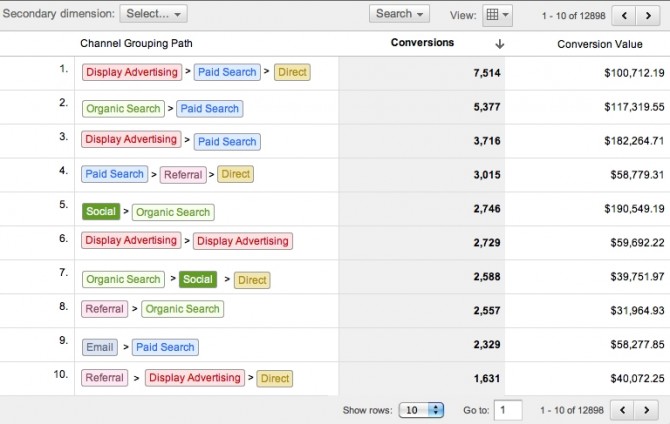The function of content marketing is very simple. Useful content aimed at a target audience leads to reads, which leads to shares and linkbacks, which leads to improved ranking, which means more traffic and sales. Simple. Yet tracking the role of content marketing in demand generation and attributing it so sales is anything but simple.
Let’s say that someone looking to go on a vacation in the Caribbean can’t decide what country they want to go to. After typing in the expected keywords, they come across a website specializing in couple’s vacations to The Dominican Republic. The vacationer-to-be leaves the site, checks the DR on Wikipedia, looks up some beaches on Google Images, then finally returns to the vacation site via Direct Traffic and purchases — of all things — not a vacation package to the DR, but a trip to Miami.
Using standard click-tracking, most business owners would think that this visitor made a Miami vacation purchase via direct traffic alone — which is not the case at all.
In reality, buyer journeys are much more complex and touch upon multiple channels over multiple devices. What’s a marketer to do? How do we get better at attributing sales to content?
How Google Analytics Can Help
If we only track the impact of the last point of interaction before a sale, we’re missing the big picture. This is what the NBA realized when it came to tracking assists. Statkeepers started tracking assists to better determine team contribution to any given goal. In recent decades, passes that led to a “one-dribble” play began to count as assists as well. In other words, statkeepers realized that the true contribution of point guards and their assists was being underrepresented.
Fortunately, Google realized the same thing about the relationship between online marketing and sales. A few years ago, Google Analytics added in multichannel funnel tracking, which helps users better visualize how online actions lead to sales across any given buy cycle.
By assigning weighted values to each interaction before the direct traffic sale, Google Analytics helps business owners understand the true contribution of content marketing. Much like the NBA’s Player Efficiency Rating (PER), assigning values greatly improves attribution accuracy.
If you aren’t already using Google Analytics, here’s a great video that explains how this works:
The Problem of Offline Sales
The problem for marketers is that Google Analytics is only useful for tracking online, e-commerce sales. For the vast majority of sellers, offline sales are still opaque.
In 2013, IMB’s Black Friday report found that the biggest social media platforms, namely Facebook, Twitter, LinkedIn and YouTube, generated only 0.34% of online sales for large retailers. SMBs benefited from their more conversational, friendlier tone of voice and did slightly better, but not by much.
Perhaps even more discouraging, U.S. retail sales in 2013 reached $4.5 trillion dollars, but only $263 billion, or 17% of these sales, happened online. In 2014, Forrester Research, Yahoo! and comScore all found that as much as 92% of all purchases worldwide occur offline following consumer activity online. Global retail sales are predicted to eclipse $22 trillion in 2015, but this percentage probably won’t change by much.
In other words, we’re still in a data dark age when it comes to offline sales. While the rise of big data clouds and the Internet of Things (IoT) has already helped coastal authorities track illegal fishing and police oceans in a way they never could before, similar applications are still years from being applied regularly to the world of sales.
Of course, there are solutions out there, but their rhetoric and attribution reliability are questionable at best. Geo-fencing, surveys, clicks, and local attribution techniques are — when you really look at the math behind them — all educated guesses. A great example of this is Adometry, recently purchased by Google, which makes large use of data mapping and predictive analytics for its attribution.
Of course, part of the problem is the reality that, to this day, sales and marketing teams still aren’t playing nice with each other the way they should. If marketers ever want to take sales “to the next level” the way we’re always talking about, finding a way to reliably map marketing to offline sales should be everyone’s priority.
Attributing Sales to Content
In Oedipus Rex, the Sphinx asks Oedipus what creature crawls on four legs in the morning, walks on two at noon, and rests on three in the evening. Oedipus correctly answers “Man”, and the Sphinx perishes. I wonder how long it will be before marketers are finally able to answer the riddles of the offline market and slay the Sphinx that is inaccurate sales attribution.









